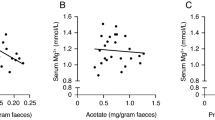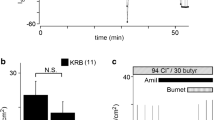Abstract
Background
Uptake of riboflavin (RF) by intestinal epithelial cells occurs via a specific carrier-mediated process that involves the apically localized RF transporter-3 (RFVT3). Previous studies have shown that sodium butyrate (NaB) affects intestinal uptake of other substrates and expression of their membrane transporters, but its effect on intestinal uptake of RF and expression of RFVT3 has not been examined.
Aims
To investigate the effect of NaB on intestinal RF uptake process and expression of the RFVT3.
Methods
Two experimental models were used in this study: Human-derived intestinal epithelial Caco-2 cells and ex vivo mouse colonoids. 3H-RF uptake assay, Western blot, RT-qPCR, and chromatin immunoprecipitation assay were performed.
Results
Treating Caco-2 cells with NaB led to a significant increase in carrier-mediated RF uptake. This increase was associated with a significant induction in the level of expression of the hRFVT3 protein, mRNA, and heterogenous nuclear RNA (hnRNA). Similarly, treating mouse colonoids with NaB led to a marked increase in the level of expression of the mRFVT3 protein, mRNA, and hnRNA. NaB did not affect hRFVT3 mRNA stability, rather it caused significant epigenetic changes (histone modifications) in the SLC52A3 gene where an increase in H3Ac and a reduction in H3K27me3 levels were observed in the NaB-treated Caco-2 cells compared to untreated controls.
Conclusion
These findings demonstrate that NaB up-regulates intestinal RF uptake and that the effect appears to be mediated, at least in part, at the level of transcription of the SLC52A3 gene and may involve epigenetic mechanism(s).







Similar content being viewed by others
References
Cooperman JM, Lopez R. Riboflavin. In: Machlin LJ, ed. Handbook of Vitamins: Nutritional, Biochemical and Clinical Aspects. New York: Dekker; 1984:299–327.
Tu BP, Ho-Schleyer SC, Travers KJ, Weissman JS. Biochemical basis of oxidative protein folding in the endoplasmic reticulum. Science. 2000;290:1571–1574.
Sanches SC, Ramalho LN, Mendes-Bras M, et al. (vitamin B-2) reduces hepatocellular injury following liver ischaemia and reperfusion in mice. Food Chem Toxicol. 2014;67:65–71.
Liu D, Zempleni J. Low activity of LSD1 elicits a pro-inflammatory gene expression profile in riboflavin-deficient human T Lymphoma Jurkat cells. Genes Nutr. 2014;9:422.
Brestoff JR, Artis D. Commensal bacteria at the interface of host metabolism and the immune system. Nat Immunol. 2013;14:676–684.
Mazur-Bialy AI, Buchala B, Plytycz B. Riboflavin deprivation inhibits macrophage viability and activity—a study on the RAW 264.7 cell line. Br J Nutr. 2013;110:509–514.
Schramm M, Wiegmann K, Schramm S, et al. Riboflavin (vitamin B2) deficiency impairs NADPH oxidase 2 (Nox2) priming and defense against Listeria monocytogenes. Eur J Immunol. 2014;44:728–741.
Fernandez-Banares F, Abad-Lacruz A, Xiol X, et al. Vitamin status in patients with inflammatory bowel disease. Am J Gastroenterol. 1989;84:744–748.
Rosenthal WS, Adham NF, Lopez R, Cooperman JM. Riboflavin deficiency in complicated chronic alcoholism. Am J Clin Nutr. 1973;26:858–860.
Kodentsova VM, Vrzhesinskaia OA, Trofimenko EV, et al. The vitamin status of children with diabetes mellitus. Vopr Med Khim. 1994;40:45–48.
Bosch AM, Abeling NG, Ijlst L, et al. Brown–Vialetto–Van Laere and Fazio Londe syndrome is associated with a riboflavin transporter defect mimicking mild MADD: a new inborn error of metabolism with potential treatment. J Inherit Metab Dis. 2011;34:159–164.
Green P, Wiseman M, Crow YJ, et al. Brown–Vialetto–Van Laere syndrome, a ponto-bulbar palsy with deafness, is caused by mutations in C20orf54. Am J Hum Genet. 2010;86:485–489.
Ho G, Yonezawa A, Masuda S, et al. Maternal riboflavin deficiency, resulting in transient neonatal-onset glutaric gciduria type 2, 1s caused by a microdeletion in the riboflavin transporter gene GPR172B. Hum Mut. 2011;32:E1976–E1984.
Johnson JO, Gibbs JR, Megarbane A, et al. Exome sequencing reveals riboflavin transporter mutations as a cause of motor neuron disease. Brain. 2012;185:2875–2882.
Iinuma S. Synthesis of riboflavin by intestinal bacteria. J Vitaminol. 1955;1:6–13. (Kyoto).
Kasper H. Vitamin absorption in the colon. Am J Protocol. 1970;21:341–345.
Said HM, Arianas P. Transport of riboflavin in human intestinal brush border membrane vesicles. Gastroenterology. 1991;100:82–88.
Sorrell MF, Frank O, Thompson AD, Aquino A, Baker H. Absorption of vitamins from the large intestine. Nutr Rep Int. 1971;3:143–148.
Middleton HM. Uptake of riboflavin by rat intestinal mucosa in vitro. J Nutr. 1985;120:588–593.
Said HM, Ma TY. Regulation of riboflavine intestinal uptake by Caco-2 cells. Am J Physiol. 1994;266:G15–G21.
Said HM, Mohammadkhani R. Uptake of riboflavin across the brush border membrane of rat intestine: regulation by dietary vitamin levels. Gastroenterology. 1993;105:1294–1298.
Yamamoto S, Inoue K, Ohta KY, et al. Identification and functional characterization of rat riboflavin transporter 2. J Biochem. 2009;145:437–443.
Yao Y, Yonezawa A, Yoshimatsu H, et al. Identification and comparative functional characterization of a new human riboflavin transporter hRFT3 expressed in the brain. J Nutr. 2010;140:1220–1226.
Yonezawa A, Masuda S, Katsura T, Inui K. Identification and functional characterization of a novel human and rat riboflavin transporter, RFT1. Am J Physiol Cell Physiol. 2008;295:C632–C641.
Yonezawa A, Inui K. Novel riboflavin transporter family RFVT/SLC52: identification, functional characterization and genetic diseases of RFVT/SLC52. Mol Aspects Med. 2013;34:693–701.
Subramanian VS, Subramanya SB, Rapp L, et al. Differential expression of human riboflavin transporters -1, -2, and -3 in polarized epithelia: a key role for hRFT-2 in intestinal riboflavin uptake. Biochim Biophys Acta. 2011;1808:3016–3021.
Subramanian VS, Lambrecht N, Lytle C, Said HM. Conditional (intestinal-specific) knockout of the riboflavin transporter-3 (RFVT-3) impairs riboflavin absorption. Am J Physiol Gastrointest Liver Physiol. 2016;310:G285–G293.
Bosch AM, Stroek K, Abeling NG, et al. The Brown–Vialetto–Van Laere and Fazio Londe syndrome revised: natural history, genetics, treatment and future perspectives. Orphanet J Rare Dis.. 2012;7:83.
Cummings JH. Short chain fatty acids in the human colon. Gut. 1981;22:763–779.
Ganapathy V, Thangaraju M, Prasad PD, Martin PM, Singh N. Transporters and receptors for short-chain fatty acids as the molecular link between colonic bacteria and the host. Curr Opin Pharmacol. 2013;13:869–874.
Cummings JH, Macfarlane GT. The control and consequences of bacterial fermentation in the human colon. J Appl Bacteriol. 1991;70:443–459.
Cummings JH, Pomare EW, Branch WJ, Naylor CP, Macfarlane GT. Short chain fatty acids in human large intestine, portal, hepatic and venous blood. Gut. 1987;28:1221–1227.
Wrong O, Metcalfe-gibson A, Morrison RB, Ng ST, Howard AV. In vivo dialysis of faeces as a method of stool analysis. i. technique and results in normal subjects. Clin Sci. 1965;28:357–375.
Roediger WE. Role of anaerobic bacteria in the metabolic welfare of the colonic mucosa in man. Gut. 1980;21:793–798.
Dalmasso G, Nguyen HT, Yan Y, et al. Butyrate transcriptionally enhances peptide transporter PepT1 expression and activity. PLoS ONE. 2008;3:e2476.
Musch MW, Bookstein C, Xie Y, Sellin JH, Chang EB. SCFA increase intestinal Na absorption by induction of NHE3 in rat colon and human intestinal C2/bbe cells. Am J Physiol Gastrointest Liver Physiol. 2001;280:G687–G693.
Xu H, McCoy A, Li J, Zhao Y, Ghishan FK. Sodium butyrate stimulates NHE8 expression via its role on activating NHE8 basal promoter activity. Am J Physiol Gastrointest Liver Physiol. 2015;309:G500–G505.
Mangian HF, Tappenden KA. Butyrate increases GLUT2 mRNA abundance by initiating transcription in Caco2-BBe cells. JPEN J Parenter Enteral Nutr. 2009;33:607–617.
Zeissig S, Fromm A, Mankertz J, et al. Butyrate induces intestinal sodium absorption via Sp3-mediated transcriptional up-regulation of epithelial sodium channels. Gastroenterology. 2007;132:236–248.
Subramanian VS, Ghosal A, Kapadia R, Nabokina SM, Said HM. Molecular mechanisms mediating the adaptive regulation of intestinal riboflavin uptake process. PLoS ONE. 2015;10:e0131698.
Sato T, Stange DE, Ferrante M, et al. Long-term expansion of epithelial organoids from human colon, adenoma, adenocarcinoma, and Barrett’s epithelium. Gastroenterology. 2011;141:1762–1772.
Tsuruta T, Saito S, Osaki Y, et al. Organoids as an ex vivo model for studying the serotonin system in the murine small intestine and colon epithelium. Biochem Biophys Res Commun. 2016;474:161–167.
Anandam KY, Srinivasan P, Subramanian VS, Said HM. Molecular mechanisms involved in the adaptive regulation of the colonic thiamin pyrophosphate uptake process. Am J Physiol Cell Physiol. 2017;313:C655–C663.
Livek KJ, Schmittgen TD. Analysis of relative gene expression data using real-time quantitative PCR and the 2(-delta DeltaC (T)) method. Methods. 2001;25:402–408.
Lakhan R, Subramanian VS, Said HM. Role of MicroRNA-423-5p in posttranscriptional regulation of the intestinal riboflavin transporter-3. Am J Physiol Gastrointest Liver Physiol. 2017;313:G589–G598.
Subramanian VS, Sabui S, Teafatiller T, Bohl JA, Said HM. Structure/functional aspects of the human riboflavin transporter-3 (SLC52A3): role of the predicted glycosylation and substrate-interacting sites. Am J Physiol Cell Physiol. 2017;313:C228–C238.
Subramanian VS, Srinivasan P, Said HM. Uptake of ascorbic acid by pancreatic acinar cells is negatively impacted by chronic alcohol exposure. Am J Physiol Cell Physiol. 2016;311:C129–C135.
Reidling JC, Nabokina SM, Said HM. Molecular mechanisms involved in the adaptive regulation of human intestinal biotin uptake: a study of the hSMVT system. Am J Physiol Gastrointest Liver Physiol. 2007;292:G275–G281.
Li G, Reinberg D. Chromatin higher-order structures and gene regulation. Curr Opin Genet Dev. 2011;21:175–186.
Vidali G, Boffa LC, Bradbury EM, Allfrey VG. Butyrate suppression of histone deacetylation leads to accumulation of multiacetylated forms of histones H3 and H4 and increased DNase I sensitivity of the associated DNA sequences. Proc Natl Acad Sci USA. 1978;75:2239–2243.
Bogliotti YS, Ross PJ. Mechanisms of histone H3 lysine 27 trimethylation remodeling during early mammalian development. Epigenetics. 2012;7:976–981.
Sabui S, Subramanian VS, Kapadia R, Said HM. Adaptive regulation of pancreatic acinar mitochondrial thiamin pyrophosphate uptake process: possible involvement of epigenetic mechanism(s). Am J Physiol Gastrointest Liver Physiol. 2017;313:G448–G455.
Ghosal A, Sabui S, Said HM. Identification and characterization of the minimal 5′-regulatory region of the human riboflavin transporter-3 (SLC52A3) in intestinal epithelial cells. Am J Physiol Cell Physiol. 2015;308:C189–C196.
Acknowledgments
This study was supported by Grants from the Department of Veterans Affairs and the NIH (Grants DK107474 to VSS, and DK58057, DK56057, and AA018071 to HMS).
Author information
Authors and Affiliations
Corresponding author
Ethics declarations
Conflict of interest
The authors declare that they have no conflict of interest.
Rights and permissions
About this article
Cite this article
Subramanian, V.S., Sabui, S., Heskett, C.W. et al. Sodium Butyrate Enhances Intestinal Riboflavin Uptake via Induction of Expression of Riboflavin Transporter-3 (RFVT3). Dig Dis Sci 64, 84–92 (2019). https://doi.org/10.1007/s10620-018-5305-z
Received:
Accepted:
Published:
Issue Date:
DOI: https://doi.org/10.1007/s10620-018-5305-z




